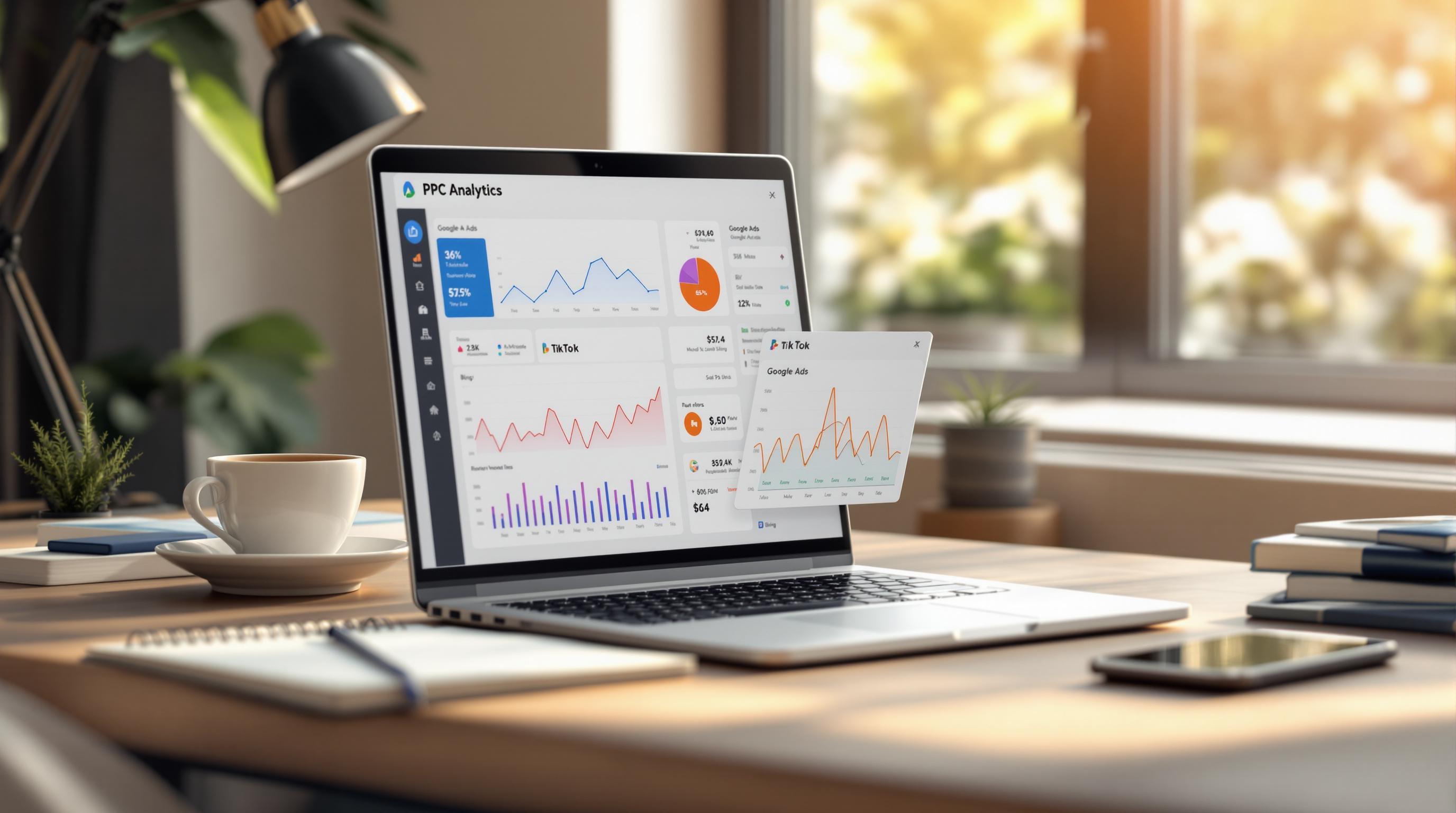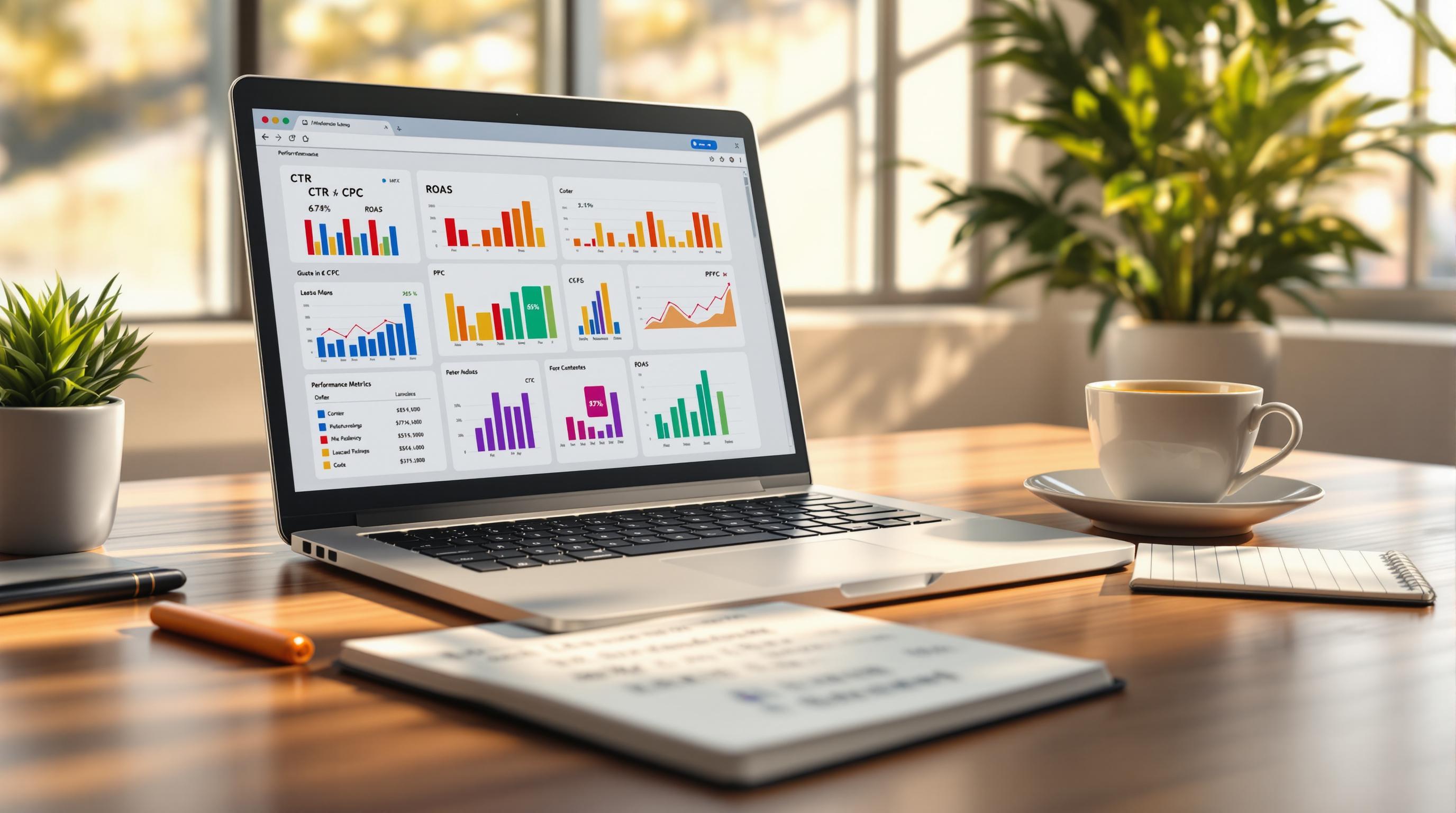If you're running ad campaigns, understanding the differences between Google Ads and Amazon Ads keyword strategies is key. Here's what you need to know:
- Google Ads targets broad search intent, great for services or digital products.
- Amazon Ads focuses on purchase-ready shoppers, ideal for physical product sales.
- Both platforms use exact, phrase, and broad match types, but their implementation differs:
- Google emphasizes close variants and broader audience reach.
- Amazon prioritizes product-specific searches and purchase intent.
- Bidding systems vary:
- Google uses automated bidding tools like Target ROAS.
- Amazon offers manual adjustments with dynamic bid options.
- Amazon shines with product-focused targeting (e.g., ASINs, categories, reviews), while Google excels in demographic and intent-based targeting.
Quick Comparison
| Feature | Google Ads | Amazon Ads |
|---|---|---|
| Primary Focus | Broad search intent | Product-specific searches |
| Targeting Options | Demographics, audience, keywords | Product categories, attributes, keywords |
| Bidding Control | Fully automated options | Manual with dynamic adjustments |
| Keyword Matching | Close variant definitions | Product-focused matching |
| Best For | Services, digital products | Physical product sales |
For eCommerce brands, Amazon Ads is perfect for targeting high-intent buyers. For broader campaigns or services, Google Ads offers unmatched reach and automation. Choose based on your goals and audience.
AdWords VS Amazon PPC - Key Similarities & Differences
How Google Ads and Amazon Ads Handle Keywords

Google Ads and Amazon Ads share some basic principles but apply them differently to suit their unique goals.
Keyword Match Types Compared
Both platforms offer exact, phrase, and broad match types, but the way they work varies. Google Ads defines close variants for exact match keywords more clearly, giving advertisers better control over when their ads appear [1]. On the other hand, Amazon's match types focus on product-related searches, emphasizing purchase intent rather than general search habits [2].
| Match Type | Google Ads | Amazon Ads |
|---|---|---|
| Exact Match | Includes close variants with the same meaning | Matches strictly to product-specific terms |
| Phrase Match | Flexible with word order | Stricter on word sequence |
| Broad Match | Covers related searches and concepts | Targets product-relevant variations |
These differences impact how well advertisers can match their campaigns to user intent.
Targeting Products on Amazon
Amazon stands out with its detailed targeting options. Advertisers can focus on:
- Specific product ASINs
- Product categories
- Brand names
- Star ratings
- Customer review counts [1]
This level of targeting helps advertisers connect with shoppers actively comparing products or browsing specific categories - something Google Ads' broader targeting can't replicate [2].
Using Automatic Targeting on Amazon
Amazon's automatic targeting for Sponsored Products pairs ads with relevant searches and products. It analyzes shopper behavior and adjusts matches based on performance, making it especially useful for:
- Launching new products with limited keyword data
- Finding unexpected but profitable keywords
- Fine-tuning manual targeting strategies using insights from automatic campaigns [1][2]
While understanding keyword differences is essential, how each platform handles bidding and campaign management also plays a major role.
Bidding and Campaign Management Differences
Automated Bidding Options on Google
Google Ads uses machine learning to power bidding strategies like Target ROAS and Maximize Conversions. It evaluates factors such as device type, location, and user intent to adjust bids in real-time [1]. This system allows advertisers to focus on their broader strategies while Google’s algorithms handle the day-to-day bid optimization.
Bid Adjustments on Amazon
Amazon takes a different route when it comes to bid management. While it doesn’t offer fully automated bidding like Google, it provides dynamic bid adjustment features that tweak bids based on the likelihood of conversions [1][2].
Amazon’s bid settings include:
- Dynamic - Down Only: Lowers bids when conversions seem unlikely.
- Dynamic - Up and Down: Adjusts bids both up and down depending on conversion chances.
- Fixed Bid: Keeps bids steady, often used for testing purposes.
The main difference here is the level of automation. Google Ads leans heavily on automation for scaling campaigns, while Amazon gives advertisers more hands-on control over bid adjustments [1][2].
For those managing campaigns across both platforms, tools like those listed in the Top PPC Marketing Directory can simplify bid management. These tools are particularly useful for navigating the varying levels of automation between Google and Amazon.
sbb-itb-89b8f36
Choosing the Right Platform for Your Business
Matching Platform to Audience and Products
Deciding between Google Ads and Amazon Ads comes down to understanding your audience and what you're offering. If you're selling physical items like electronics or clothing, Amazon is a strong choice due to its product-focused ecosystem. On the other hand, Google Ads shines when promoting services or digital products, thanks to its detailed demographic targeting options [1][2].
Here's a quick look at how their targeting options compare:
| Targeting Options | Google Ads | Amazon Ads |
|---|---|---|
| Age & Gender | ✓ | Limited |
| Household Income | ✓ | Limited |
| Interests & Hobbies | ✓ | Product-based |
| Device Type | ✓ | ✓ |
| Location | Advanced | Basic |
Budget and Advertising Goals
Your advertising goals also play a major role in picking the right platform. Google Ads works well for increasing brand visibility, driving website traffic, and promoting services. Meanwhile, Amazon Ads is more effective for boosting product sales and reaching shoppers who are ready to make a purchase [1][2].
After choosing the right platform, focus on refining your keyword strategy to get the most out of your campaign.
Improving Keyword Strategies for Each Platform
Finding High-Converting Keywords on Amazon
Amazon's keyword strategy revolves around understanding purchase intent. By using tools like Sponsored Products automatic campaigns, you can access the Search Term Report to identify keywords that drive conversions [3]. This data helps pinpoint product-specific details and brand-related terms that shoppers frequently search for.
Here’s a breakdown of how different keyword types can be used effectively on Amazon:
| Keyword Type | Best Use Case | Example |
|---|---|---|
| Product Features | Highlight specific details | Material type, size, color |
| Brand Names | Target branded searches | Product name + brand |
| Category Terms | Reach a wider audience | Generic product category |
| Purchase Intent | Appeal to ready buyers | "best", "top-rated", "professional" |
Keeping a close eye on campaign performance helps ensure your keywords stay optimized for conversions.
Combining SEO and PPC for Better Results
Merging organic SEO techniques with PPC efforts can amplify your results on platforms like Amazon and Google. For example, on Amazon, you can use keywords discovered through PPC campaigns to improve your product listings. This boosts both organic rankings and sponsored ad visibility [5][3]. Amazon’s focus on purchase-driven searches aligns well with Google’s broader targeting capabilities.
Here are some strategies for integrating SEO and PPC effectively:
| Strategy | Amazon Implementation | Google Implementation |
|---|---|---|
| Keyword Research | Use Search Term Report data | Leverage Search Console data |
| Content Optimization | Improve product listings | Enhance landing pages |
| Performance Tracking | Monitor ROAS and conversions | Track Quality Score and CTR |
For the best results, keep your listings accurate and mobile-friendly. Incorporate top-performing keywords naturally to improve both organic search rankings and sponsored placements [5].
Conclusion
To achieve success across advertising platforms, it's essential to play to each platform's strengths. Google Ads is ideal for reaching a wide audience and utilizing advanced automation, while Amazon Ads connects sellers with shoppers who are ready to make a purchase [1][2].
Each platform serves distinct goals:
- Google Ads: Perfect for targeting a broad audience and promoting services or digital products with its advanced demographic tools.
- Amazon Ads: Designed for sellers aiming to reach high-intent shoppers through precise product-based targeting [1][4].
Your keyword strategy should align with the platform's strengths. On Google, tools like automated bidding and transparent match types work well for broader marketing objectives. On Amazon, product-specific targeting is key for driving direct sales [1][2].
To maximize performance on both platforms, explore specialized tools available through the Top PPC Marketing Directory. These resources can help sharpen keyword strategies and improve campaign results.
FAQs
Which is better, Google Ads or Amazon Ads?
The choice between Google Ads and Amazon Ads depends on what you're trying to achieve. Here's a quick comparison:
| Platform | Ideal For | Key Strengths |
|---|---|---|
| Amazon Ads | eCommerce brands | Targets high-intent shoppers, automated campaigns |
| Google Ads | Direct-to-consumer brands | Reaches a broader audience, advanced automation tools |
"Each platform's strengths align with specific business goals, such as Amazon for product sales and Google for broader audience reach." [1][2]
Here are some factors to help you decide:
- Audience Type: Amazon works well for buyers ready to purchase, while Google helps build awareness and consideration.
- Product Fit: Physical goods perform better on Amazon, while Google is great for services or digital products.
- Marketing Goals: Amazon focuses on driving direct sales, whereas Google supports a full-funnel approach.
Both platforms offer powerful tools to meet your advertising needs:
- Amazon Ads: Great for precise product targeting with automated optimization.
- Google Ads: Ideal for reaching diverse audiences with tools for broader marketing strategies.
For better results on either platform, check out the Top PPC Marketing Directory. It offers resources and tools to help fine-tune your campaigns and boost performance [1][2].


